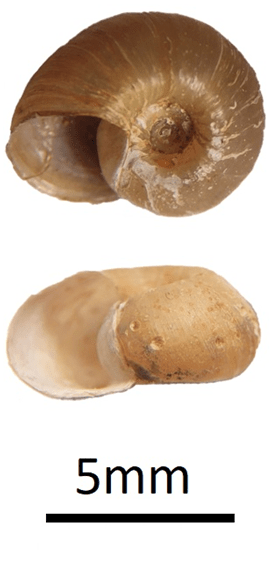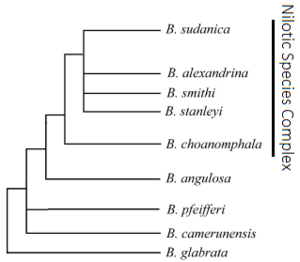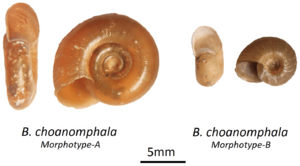Biomphalaria choanomphala facts for kids
Quick facts for kids Biomphalaria choanomphala |
|
|---|---|
 |
|
| Top and side view of Biomphalaria choanomphala. | |
| Scientific classification |
Biomphalaria choanomphala is a type of freshwater snail. It's a snail that breathes air and lives in water. These snails belong to a group called "ram's horn snails" because their shells look a bit like a ram's horn.
This snail has a round, flat, brownish-yellow shell. Its shell is usually about 6 to 10 millimeters wide. Biomphalaria choanomphala is important because it can carry a tiny parasite called Schistosoma. This parasite can cause a disease in humans.
Contents
Where it Lives
Biomphalaria choanomphala is found in Africa. It lives in freshwater places like rivers, streams, and ponds. These snails like water that moves slowly and has lots of plants. They eat algae and tiny bits of dead plants and animals.
The snail has two tentacles on its head, with eyes at the bottom of each. It also has a special tube called a siphon. It uses this siphon for breathing and getting rid of waste.
Places it is Found
You can find Biomphalaria choanomphala in:
- East Africa: Especially in Lake Victoria, which touches Kenya, Tanzania, and Uganda.
Its Role in Nature
Biomphalaria choanomphala plays a special role in its freshwater home. It helps keep the water clean by eating algae and other tiny bits of food. Many animals also eat these snails, like fish, birds, and other small creatures.
Carrying Parasites
This snail is known to carry a tiny worm-like parasite called Schistosoma mansoni. This parasite causes a disease in humans called intestinal schistosomiasis. The snail acts as a "middle host" for the parasite. This means the parasite needs the snail to complete part of its life cycle.
If people touch water where these snails live and the water has the parasite, they can get sick. This is why controlling these snails is important for human health.
Protecting the Snail
Biomphalaria choanomphala is not a species that is in danger of disappearing. There are many of them in the places they naturally live.
However, because these snails can carry the parasite that causes schistosomiasis, they are important for health programs. Scientists and health workers try to control the snail population. They do this to help reduce the number of people who get sick from the parasite.
Snail Shapes and Environment
Scientists have studied Biomphalaria choanomphala a lot. They found that the shape of its shell can change depending on where it lives. Snails from Lake Victoria might look different from snails found in other places. Even if their shells look different, they can still be the same species. This is because the environment can affect how their shells grow.
Scientists call these different shapes "ecophenotypes." It means the same species can have different looks based on its environment. For example, snails found in lakes might have one shell shape, while those found in rivers might have another.



